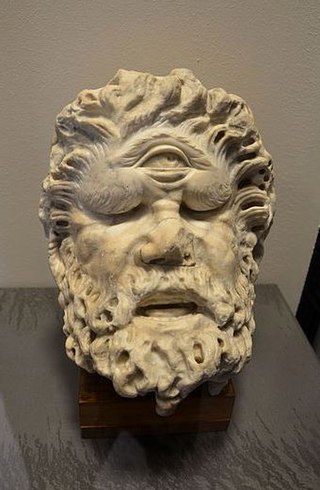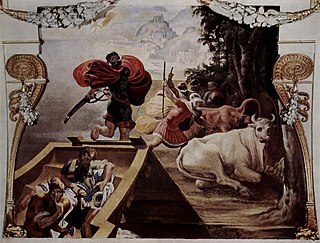

The Cyclopean Isles (Italian: Isole Ciclopi), noted for their rows of basaltic columns piled one above another, lie not far from Mount Etna off the eastern coast of Sicily in the Mediterranean Sea.


The Cyclopean Isles (Italian: Isole Ciclopi), noted for their rows of basaltic columns piled one above another, lie not far from Mount Etna off the eastern coast of Sicily in the Mediterranean Sea.
Formed about 500,000 years ago, the Cyclopean Isles are of volcanic origin and may at one time have been attached to Sicily.
The Cyclopean Isles strongly resemble the Giant's Causeway on the northern coast of Northern Ireland, and the Isle of Staffa off the western coast of Scotland. The latter, closest in appearance to the Cyclopean pair, differs mainly in having the columns piled in terraces, one above another.
There is an ancient tradition that the islands at one time formed part of the mainland of Sicily.
Homer has a curious story about the manner in which they became detached, towards the end of the ninth book of the Odyssey . When Odysseus visited Sicily it was inhabited by the Cyclopes, said to have had only one eye, on the forehead.
Odysseus encounters one of their number, Polyphemus, on his journey home to Ithaca, who kills two of Odysseus's men. Stuck inside Polyphemus's cave because he and his men are unable to move the boulder that blocks the entrance, Odysseus supplies Polyphemus with a special wine until he falls asleep, and blinds him by drilling the Cyclops's own wooden walking stick into his eye. Polyphemus opens the cave boulder and the Greeks escape to their ship; Polyphemus calls to the other Cyclopes for help and Odysseus, from the distance of his ship, begins to taunt and to jeer at him. Homer (Alexander Pope's translation) says:
These words the Cyclops' burning rage provoke:
From the tall hill he rends a pointed rock;
High o'er the billows flew the massy load,
And near the ship came thund'ring on the flood.
It almost brushed the helm, and fell before:
The whole sea shook, and refluent beat the shore.
Odysseus boasts that it was "Odysseus ... Son of Laertes" who had burnt out Polyphemus's eye. Polyphemus invokes the vengeance of his father Poseidon, and:
A larger rock then heaving from the plain,
He whirled it round--it rung across the main:
It fell and brushed the stern: the billows roar,
Shake at the weight, and refluent beat the shore.
37°33′41.4″N15°09′58.7″E / 37.561500°N 15.166306°E

The Odyssey is one of two major ancient Greek epic poems attributed to Homer. It is one of the oldest extant works of literature still widely read by modern audiences. As with the Iliad, the poem is divided into 24 books. It follows the Greek hero Odysseus, king of Ithaca, and his journey home after the Trojan War. After the war, which lasted ten years, his journey from Troy to Ithaca, via Africa and southern Europe, lasted for ten additional years during which time he encountered many perils and all of his crewmates were killed. In his absence, Odysseus was assumed dead, and his wife Penelope and son Telemachus had to contend with a group of unruly suitors who were competing for Penelope's hand in marriage.

Polyphemus is the one-eyed giant son of Poseidon and Thoosa in Greek mythology, one of the Cyclopes described in Homer's Odyssey. His name means "abounding in songs and legends", "many-voiced" or "very famous". Polyphemus first appeared as a savage man-eating giant in the ninth book of the Odyssey. The satyr play of Euripides is dependent on this episode apart from one detail; Polyphemus is made a pederast in the play. Later Classical writers presented him in their poems as heterosexual and linked his name with the nymph Galatea. Often he was portrayed as unsuccessful in these, and as unaware of his disproportionate size and musical failings. In the work of even later authors, however, he is presented as both a successful lover and skilled musician. From the Renaissance on, art and literature reflect all of these interpretations of the giant.

In Greek mythology and later Roman mythology, the Cyclopes are giant one-eyed creatures. Three groups of Cyclopes can be distinguished. In Hesiod's Theogony, the Cyclopes are the three brothers Brontes, Steropes, and Arges, who made for Zeus his weapon the thunderbolt. In Homer's Odyssey, they are an uncivilized group of shepherds, the brethren of Polyphemus encountered by Odysseus. Cyclopes were also famous as the builders of the Cyclopean walls of Mycenae and Tiryns.

In the Aeneid of Virgil, Achaemenides was a son of Adamastos of Ithaca, and one of Ulysses's crew. He was marooned on Sicily when Ulysses fled the Cyclops Polyphemus, until Aeneas arrived and took him to Italy with his company of refugee Trojans.
In Greek mythology, Eurylochus appears in Homer's Odyssey as second-in-command of Odysseus' ship during the return to Ithaca after the Trojan War. He is portrayed as an unpleasant, cowardly individual who undermines Odysseus and stirs up trouble.
Telemus was a figure of Greek mythology, a prophet, son of Eurymus. Telemus warned the Cyclops Polyphemus that he would lose his sight to a man named Odysseus.

In Greek mythology, the Laestrygonians or Laestrygones were a tribe of man-eating giants. They were said to have sprung from Laestrygon, son of Poseidon.

Aci Trezza is a town in Sicily, southern Italy, a frazione of the comune of Aci Castello, c. 10 km north of Catania, with a population of around 5,000 people.

The Odyssey is a 1997 American mythology–adventure television miniseries based on the ancient Greek epic poem by Homer, the Odyssey. Directed by Andrei Konchalovsky, the miniseries aired in two parts beginning on May 18, 1997, on NBC. It was filmed in Malta, Turkey, parts of England and many other places around the Mediterranean, where the story takes place. The cast includes Armand Assante, Greta Scacchi, Irene Papas, Isabella Rossellini, Bernadette Peters, Eric Roberts, Geraldine Chaplin, Jeroen Krabbé, Christopher Lee and Vanessa Williams.
Philoxenus of Cythera was a Greek dithyrambic poet, an exponent of the "New Music". He was one of the most important dithyrambic poets of ancient Greece.

Tartaro, Tartalo, or Torto in Basque mythology, is an enormously strong one-eyed giant very similar to the Greek Cyclops that Odysseus faced in Homer's Odyssey. He is said to live in caves in the mountains and catches young people in order to eat them; in some accounts he eats sheep also.

Cyclops is an ancient Greek satyr play by Euripides, based closely on an episode from the Odyssey. It would have been the fourth part of a tetralogy presented by Euripides in a dramatic festival in 5th Century BC Athens. The date of its composition is unknown, but it was probably written late in Euripides' career. It is the only complete satyr play extant.
The Odyssean gods are the ancient Greek gods referenced in Homer's Odyssey.

The locations mentioned in the narratives of Odysseus's adventures have long been debated. Events in the main sequence of the Odyssey take place in the Peloponnese and in what are now called the Ionian Islands. There are also incidental mentions of Troy and its house, Phoenicia, Egypt, and Crete, which hint at a geographical knowledge equal to, or perhaps slightly more extensive than that of the Iliad. The places visited by Odysseus in his journey have been variously identified with locations in Greece, Italy, Africa, the Maltese archipelago, and the Iberian peninsula. However, scholars both ancient and modern are divided whether any of the places visited by Odysseus were real. Many ancient writers came down squarely on the skeptical side; Strabo reported what the great geographer Eratosthenes had said in the late 3rd century BC: "You will find the scene of Odysseus' wanderings when you find the cobbler who sewed up the bag of winds."
Outis is an often used pseudonym that appeared famously in Classical Greek legends. Modern artists, writers, and others in public life have adopted the use of this pseudonym in order to hide their identity and it has been used for fictional characters as well.

Ulysses is a 1954 fantasy-adventure film based on Homer's epic poem Odyssey. The film was directed by Mario Camerini, who co-wrote the screenplay with writer Franco Brusati. The original choice for director was Georg Wilhelm Pabst but he quit at the last minute. The film's cinematographer Mario Bava co-directed the cyclops Polyphemus segment (uncredited).

In Greek mythology, the Cattle of Helios, also called the Oxen of the Sun, are cattle pastured on the island of Thrinacia, or Thrinakia,.

The Odyssey is an eight-episodes European TV miniseries broadcast on RAI in 1968 and based on Homer's Odyssey. An Italian, Yugoslavian, German and French coproduction, it was directed by Franco Rossi, assisted by Piero Schivazappa and Mario Bava; the cast includes Bekim Fehmiu as Odysseus and Irene Papas as Penelope, Samson Burke as the Cyclops, as well as Barbara Bach as Nausicaa, and Gérard Herter. Several critics consider the series to be a masterful representation of the ancient world.

Ulysses Deriding Polyphemus is an 1829 oil painting by Joseph Mallord William Turner. It depicts a scene from Homer's Odyssey, showing Odysseus (Ulysses) standing on his ship deriding Polyphemus, one of the cyclopes he encounters and has recently blinded, who is disguised behind one of the mountains on the left side. Additional details include the Trojan Horse, a scene from Virgil's Aeneid, on one of the flags and the horses of Apollo rising above the horizon. This painting is thought to be quickly done as a replacement for previous paintings submitted to the Academy that had been delayed. The painting was exhibited at the Royal Academy of Arts in 1829. Acquired by the National Gallery in 1856, the painting is on display in room 34.

Odysseus and Polyphemus is an 1896 oil painting by the Swiss artist Arnold Böcklin. It has been part of the collection of the Museum of Fine Arts, Boston, since 2012.